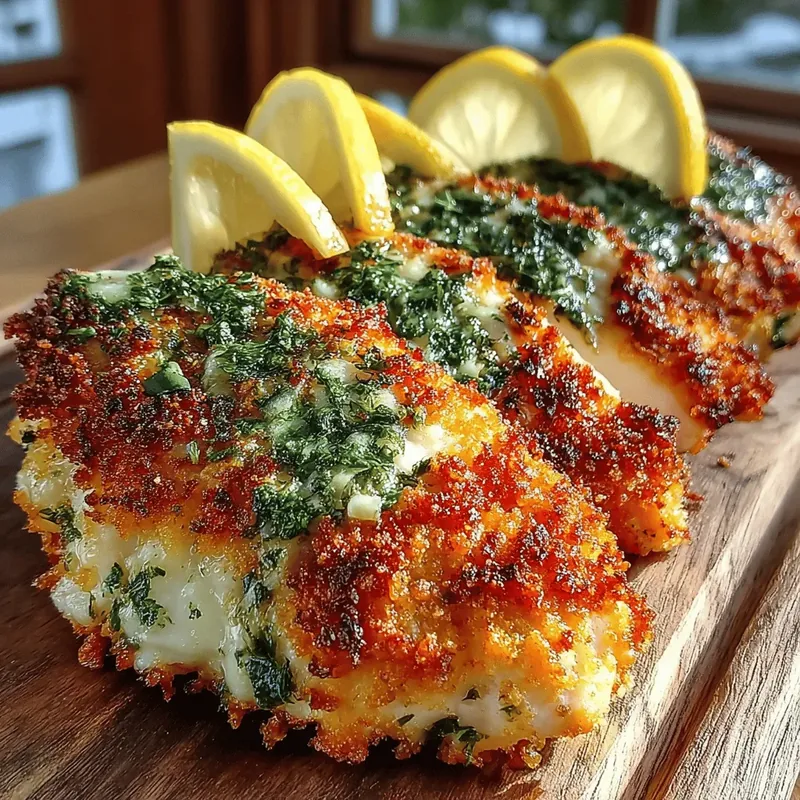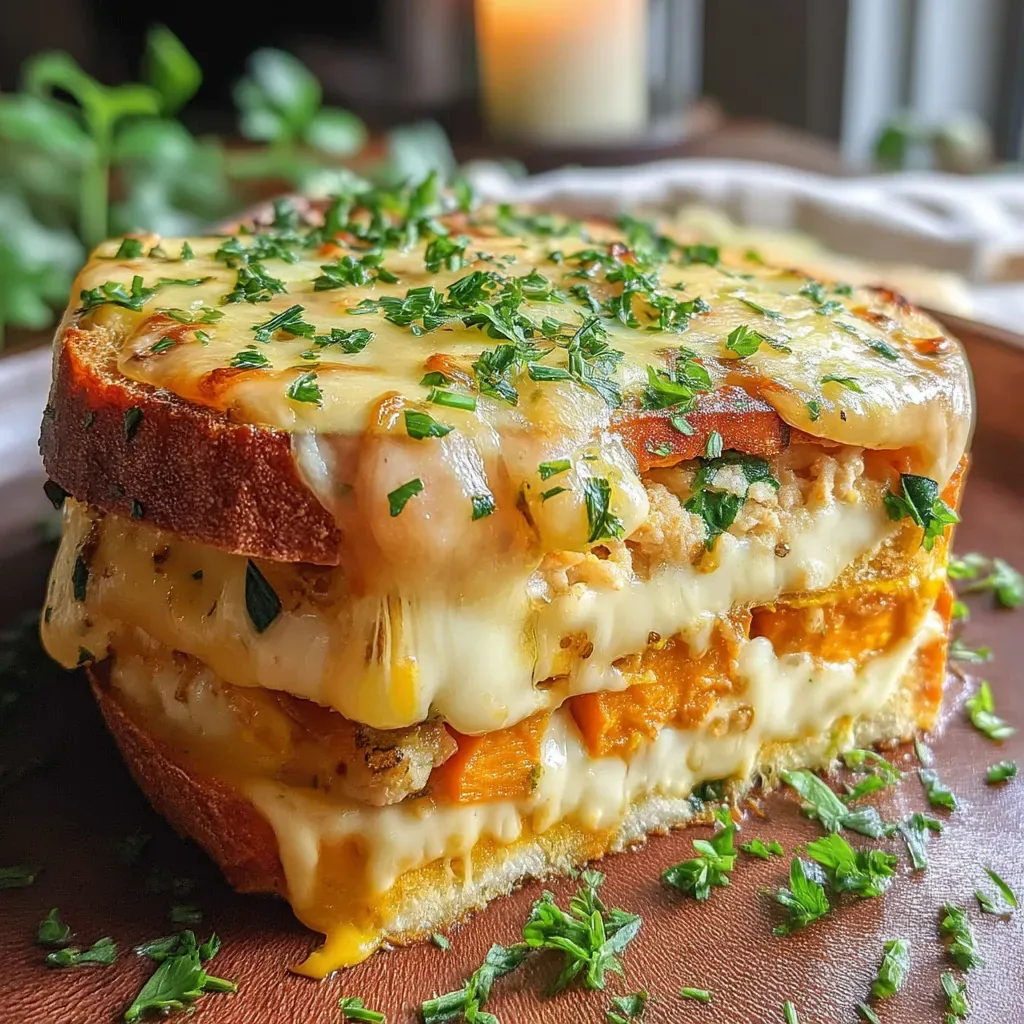Imagine a chicken breast so crisp on the outside that it shatters like a golden shell, yet remains tender and juicy within. That’s the magic of a Parmesan herb crust—an instant upgrade that feels restaurant‑worthy without the fuss.
What makes this dish special is the harmonious blend of sharp Parmesan, fragrant fresh herbs, and a light breadcrumb crunch that locks in moisture while delivering a burst of flavor in every bite.
Busy families, weekend entertainers, and anyone who craves a comforting yet elegant dinner will love this recipe. It shines at weeknight meals, casual brunches, or as the centerpiece of a relaxed dinner party.
The process is straightforward: season the chicken, dip it in a flour‑egg‑breadcrumb sequence, bake it to perfection, and finish with a buttery herb‑infused pan sauce that ties everything together.
Why You'll Love This Recipe
Crunchy Meets Creamy: The Parmesan‑herb crust provides a satisfying crunch, while the pan sauce adds a velvety richness that balances texture beautifully.
Quick Weeknight Solution: With under 30 minutes of active prep and a single oven finish, you can serve a gourmet‑style dinner on a busy schedule.
Customizable Flavor Profile: Fresh herbs, optional lemon, and a hint of smoked paprika let you tweak the taste to match any palate or season.
Nutritious Protein Boost: Lean chicken breast delivers high‑quality protein, while the modest amount of cheese and herbs adds calcium and antioxidants.
 Ingredients
Ingredients

The backbone of this dish is fresh, high‑quality chicken paired with a flavorful herb‑Parmesan coating. The crust relies on panko for lightness, while grated Parmesan adds umami depth. Fresh herbs such as parsley and thyme brighten the profile, and a simple butter‑enriched pan sauce ties everything together. Together these components create a balanced, satisfying plate that feels both comforting and refined.
Main Ingredients
- 4 boneless, skinless chicken breasts
- 1/2 cup all‑purpose flour
- 2 large eggs, lightly beaten
Herb Crust
- 1 cup panko breadcrumbs
- 1/2 cup grated Parmesan cheese
- 2 tablespoons fresh parsley, finely chopped
- 1 tablespoon fresh thyme leaves
- 1 teaspoon garlic powder
- 1/2 teaspoon smoked paprika
- Salt and freshly ground black pepper, to taste
Pan Sauce
- 2 tablespoons olive oil
- 2 tablespoons unsalted butter
- 1/4 cup chicken broth
- 1/4 cup heavy cream
- 1 tablespoon fresh lemon juice
Each component plays a purpose: the flour creates a dry surface for the egg wash, the egg adds adhesion, and the panko‑Parmesan mixture forms the crunchy shell. The butter‑olive oil base enriches the sauce, while the broth, cream, and lemon bring depth, silkiness, and a bright finish that lifts the entire plate.
Step-by-Step Instructions
Preparing the Chicken
Pat the chicken breasts dry with paper towels, then place them between two sheets of plastic wrap. Using a meat‑mallet or rolling pin, gently pound each piece to an even ½‑inch thickness. This uniform thickness ensures the crust cooks evenly and the interior reaches the safe 165°F temperature without drying out.
Seasoning and Dredging
- Season. Sprinkle both sides of each breast with salt, pepper, and a pinch of smoked paprika. Let sit for 5 minutes so the seasoning penetrates the meat.
- Flour coat. Place the flour in a shallow dish. Dredge each breast, shaking off excess. The flour creates a dry surface that helps the egg adhere.
- Egg wash. Transfer the beaten eggs to another shallow bowl. Dip the flour‑coated breasts into the egg, ensuring a thin, even coating.
- Herb‑Parmesan crust. Combine panko, Parmesan, parsley, thyme, garlic powder, and a little extra pepper in a third dish. Press each egg‑coated breast into the mixture, turning to coat all sides. A firm press guarantees the crumbs stick during baking.
Baking the Chicken
Preheat your oven to 375°F (190°C). Heat olive oil and butter together in a large oven‑safe skillet over medium‑high heat until the butter foams. Carefully lay the crusted breasts in the pan, skin‑side down, and sear for 2‑3 minutes until the crust turns golden. Flip once, then transfer the skillet to the oven and bake for 15‑18 minutes, or until an instant‑read thermometer registers 165°F at the thickest point.
Making the Pan Sauce
Remove the chicken to a warm plate and tent with foil. Reduce the heat to medium and add the chicken broth to the skillet, scraping up browned bits with a wooden spoon—these are flavor gold. Stir in the heavy cream and lemon juice, allowing the sauce to simmer for 2‑3 minutes until it thickens slightly. Taste and adjust seasoning with salt or a splash more lemon if needed. Spoon the sauce over the rested chicken before serving.
Tips & Tricks
Perfecting the Recipe
Dry the chicken. Moisture is the enemy of a crisp crust; pat the breasts dry before any coating.
Use panko, not regular breadcrumbs. Panko stays light and airy, giving the crust its signature crunch.
Press the crust firmly. A good press locks the crumbs onto the chicken, preventing them from falling off during baking.
Rest after baking. Let the chicken rest 5 minutes; this redistributes juices and keeps the meat moist.
Flavor Enhancements
Add a pinch of red‑pepper flakes to the crust for subtle heat, or finish the sauce with a teaspoon of Dijon mustard for a tangy depth. A drizzle of extra‑virgin olive oil just before serving brightens the final bite.
Common Mistakes to Avoid
Skipping the resting step will cause the juices to spill out, leaving the meat dry. Also, avoid turning the heat up too high while searing; the crust will burn before the interior cooks through.
Pro Tips
Use a meat thermometer. This guarantees perfectly cooked chicken without guesswork.
Pre‑heat the skillet. A hot pan creates an immediate sear, locking in moisture.
Finish with fresh herbs. A sprinkle of parsley or chives right before serving adds a burst of color and freshness.
Save the sauce. If you have extra pan sauce, whisk in a little more cream and serve as a drizzle for leftovers.
Variations
Ingredient Swaps
Replace chicken with turkey cutlets for a leaner option, or use firm tofu slices for a vegetarian twist. Swap Parmesan for Pecorino Romano for a sharper bite, and experiment with herbs—basil, oregano, or rosemary each bring a distinct Mediterranean flair.
Dietary Adjustments
For gluten‑free diners, use almond flour instead of all‑purpose flour and certified gluten‑free panko. To make the dish dairy‑free, substitute butter with a plant‑based margarine and use nutritional yeast in place of Parmesan. Keto lovers can omit the flour, dip the chicken directly into the egg, then coat with a mixture of crushed pork rinds and Parmesan.
Serving Suggestions
Serve over a bed of lemon‑herb quinoa for a light, protein‑rich plate, or pair with roasted garlic mashed cauliflower for a low‑carb comfort side. A crisp arugula salad dressed with a simple vinaigrette adds a peppery contrast that cuts through the richness of the sauce.
Storage Info
Leftover Storage
Allow the chicken and sauce to cool to room temperature, then transfer to an airtight container. Refrigerate for up to 4 days. For longer keeping, portion into freezer‑safe bags, squeeze out excess air, and freeze for up to 3 months. Thaw overnight in the fridge before reheating.
Reheating Instructions
Reheat in a preheated 350°F oven, covered with foil, for 12‑15 minutes until the interior reaches 165°F. This method revives the crisp crust while keeping the meat juicy. In a microwave, add a splash of broth, cover loosely, and heat on medium for 2‑3 minutes, stirring halfway through.
Frequently Asked Questions
This Parmesan Herb Crusted Chicken Breast brings together crunch, creaminess, and bright herb notes in a single, satisfying plate. By following the detailed steps, using fresh ingredients, and applying the pro tips, you’ll achieve a restaurant‑quality result every time. Feel free to experiment with the suggested swaps or add your own twist—cooking is an adventure. Serve hot, enjoy the compliments, and relish every bite of your delicious creation!











